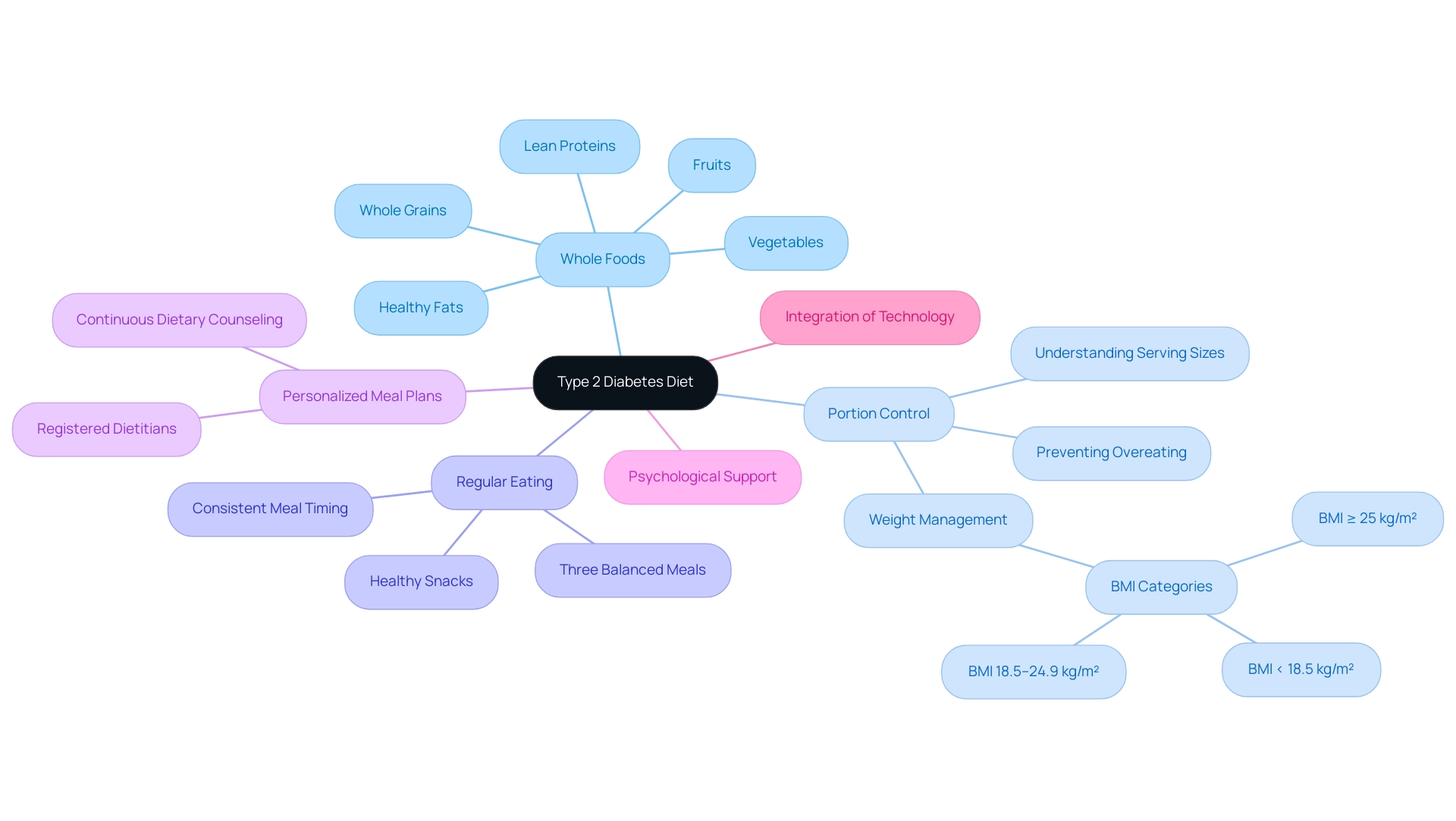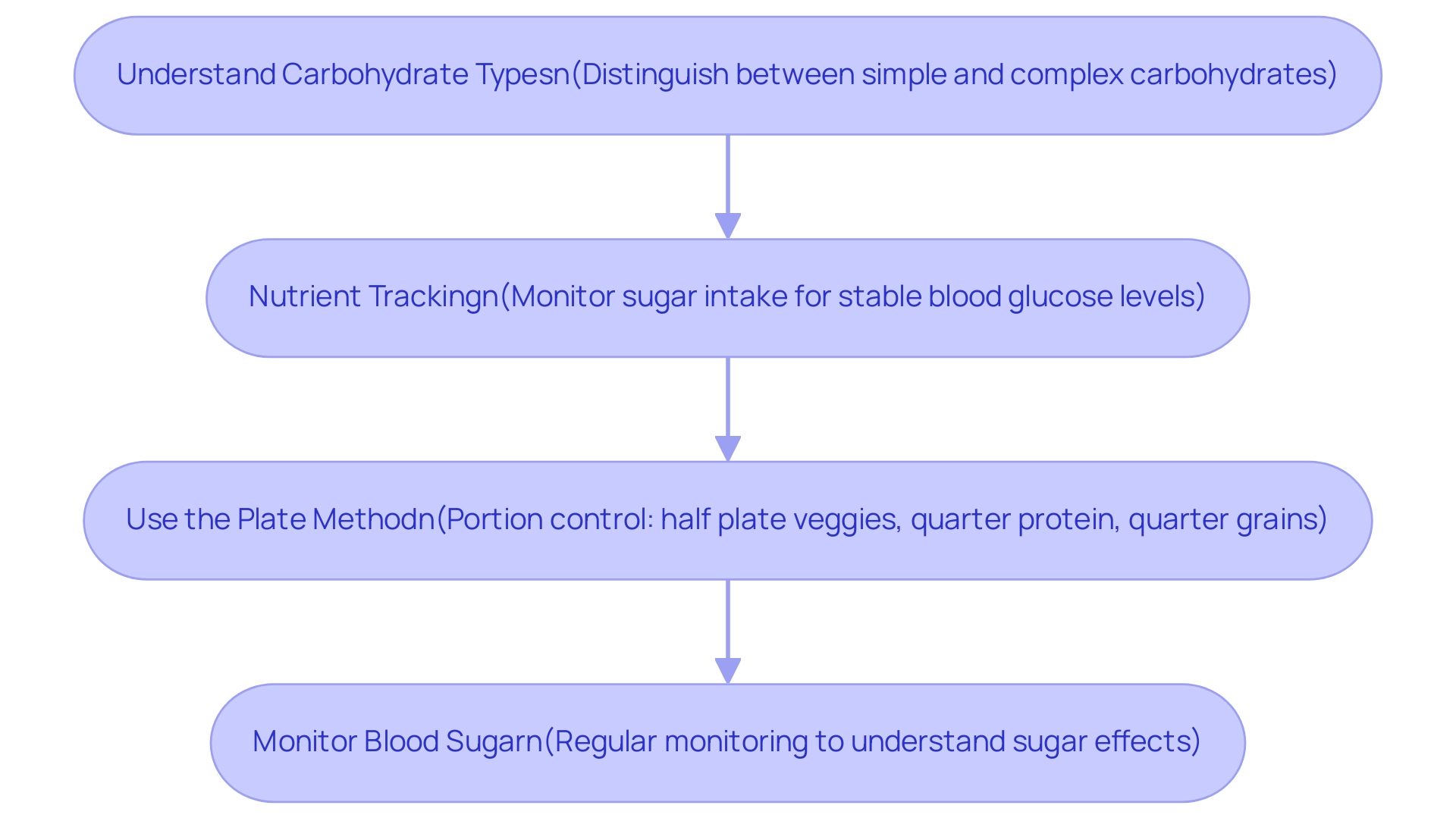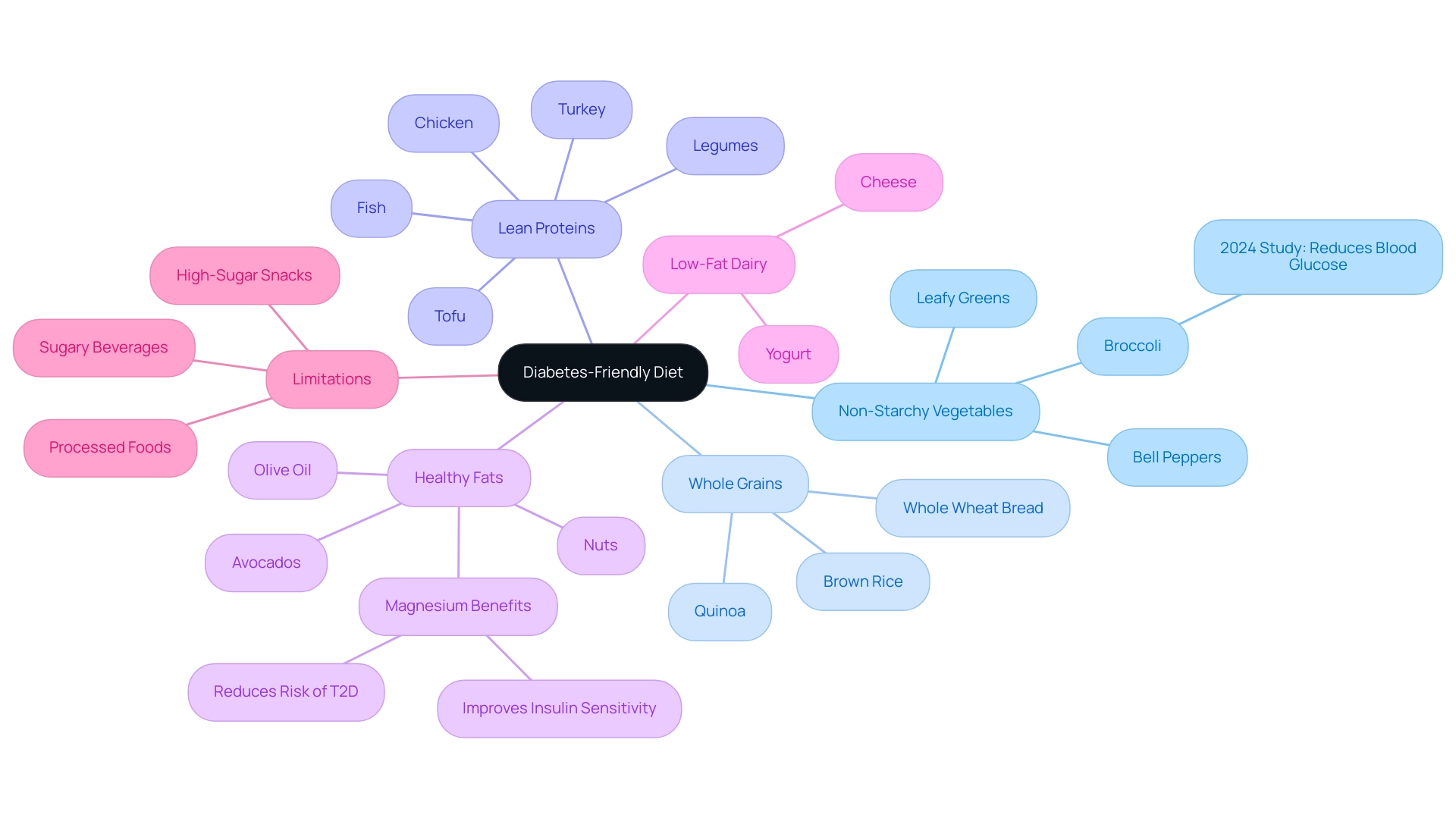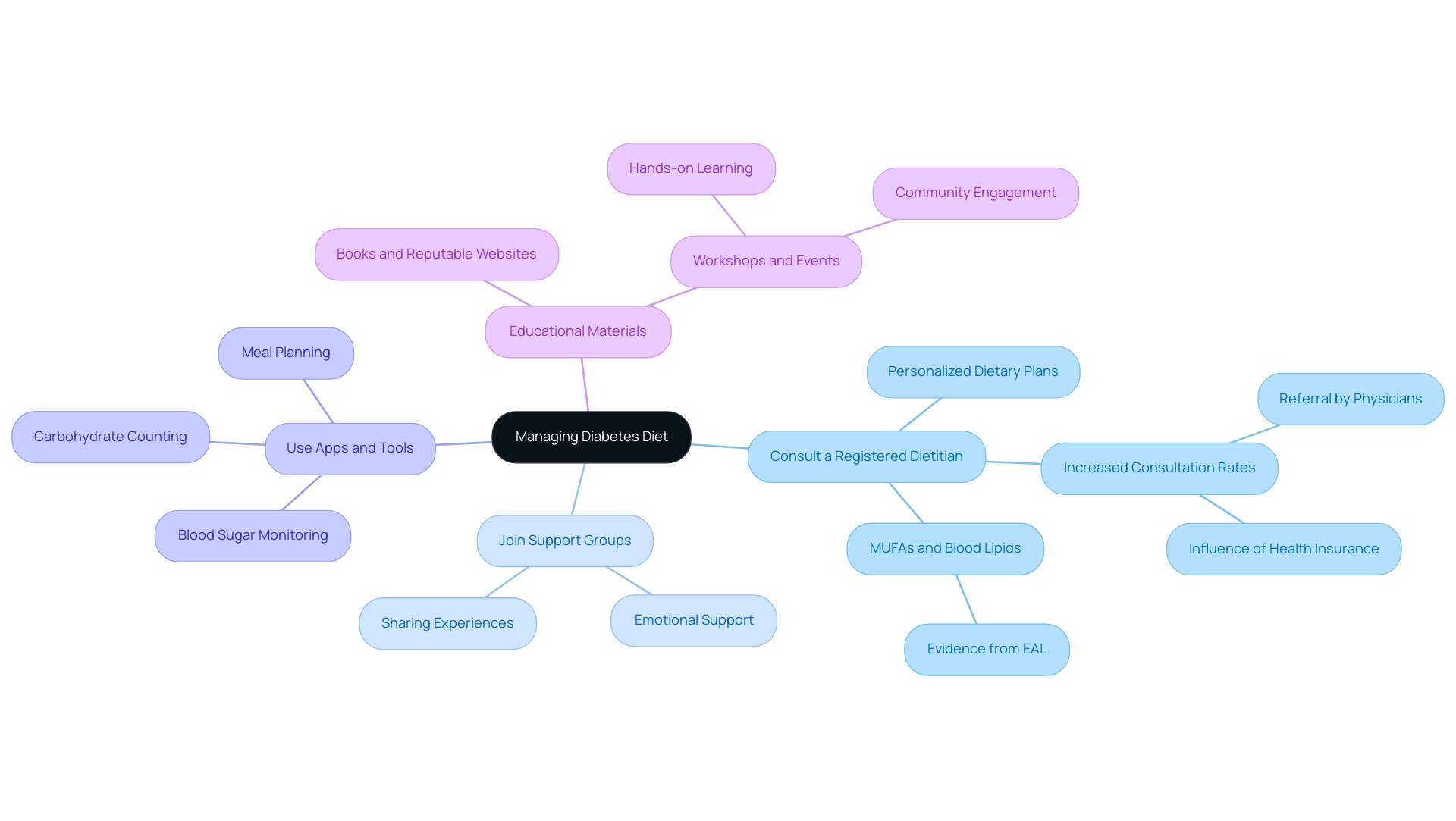Overview:
Creating your own Type 2 diabetes diet sheet PDF involves understanding key dietary principles such as prioritizing whole foods, practicing portion control, and planning meals effectively to manage blood sugar levels. The article outlines a structured approach to meal planning and emphasizes the importance of utilizing resources like registered dietitians and support groups to enhance dietary management, thereby facilitating better health outcomes for individuals with Type 2 diabetes.
Introduction
Navigating a diabetes-friendly diet can be a daunting task, particularly for those newly diagnosed with Type 2 diabetes. A well-structured dietary approach is essential not only for managing blood sugar levels but also for enhancing overall health and well-being. This article delves into the fundamental principles of a Type 2 diabetes diet, effective meal planning strategies, and the critical role of carbohydrate management.
With the launch of T2DSolutions as a dedicated resource hub, individuals can access valuable information and community support tailored to their unique needs. By understanding the nuances of food choices and utilizing available resources, individuals can take proactive steps toward better diabetes management and improved health outcomes.
Understanding the Basics of a Type 2 Diabetes Diet
A well-structured type 2 diabetes diet sheet pdf for managing Type 2 conditions is pivotal for maintaining stable blood sugar levels, which can be effectively achieved through balanced nutrition. As T2DSolutions launches as a new resource hub for Type 2 and Type 3 diabetes education and community support, it is essential to understand the fundamental components of such a diet:
- Whole Foods: Prioritize the intake of whole grains, fruits, vegetables, lean proteins, and healthy fats. Whole foods are not only nutrient-dense but also have a lower glycemic index, which can aid in blood sugar control.
- Portion Control: A clear understanding of serving sizes is essential in preventing overeating and effectively managing caloric intake. This approach supports weight management, which is crucial for individuals with Type 2 diabetes, particularly considering BMI categories where a BMI of ≥ 25 kg/m² indicates overweight status.
- Regular Eating: Consistently timed food intake plays a significant role in regulating blood sugar levels. It is advisable to aim for three balanced dishes complemented by healthy snacks, as necessary.
As Meghan O’Hearn, Impact Director for Food Systems for the Future, states, "These findings can help inform nutritional priorities for clinicians, policymakers, and private sector actors as they encourage healthier dietary choices that address this global epidemic." By grasping these fundamental dietary principles, you can start to develop a personalized food plan that aligns with your specific nutritional needs, which can be guided by the type 2 diabetes diet sheet pdf.
At T2DSolutions, we are committed to enhancing your health journey by offering resources like a type 2 diabetes diet sheet pdf and access to community support forums. Furthermore, our forthcoming blog entries will showcase the newest insights and updates on blood sugar control strategies. Recent studies emphasize the effectiveness of whole foods in blood sugar control, highlighting their positive impact on glycemic regulation and overall health results.
Moreover, the case study titled "Unmet Needs in Nutritional Treatment" emphasizes the significance of effective dietary plans, psychological support, and the integration of technology for adherence in managing Type 2. T2DSolutions is dedicated to offering the essential resources and community support to empower you in your health management journey.

Effective Meal Planning for Type 2 Diabetes
To effectively plan dishes using the type 2 diabetes diet sheet pdf, adhere to the following structured steps:
-
Create a Weekly Menu:
Begin by outlining your dishes for the week, encompassing breakfast, lunch, dinner, and snacks. This structured method simplifies shopping and food preparation, ensuring you have the necessary ingredients on hand. -
Incorporate Variety:
Emphasizing a diverse array of proteins, whole grains, and vegetables is crucial to prevent dietary monotony and achieve nutritional balance. Including high-fiber food sources, as emphasized in recent studies, can improve satisfaction during dining while assisting in glucose regulation.
This aligns with the carbohydrate counting strategy, which helps individuals estimate carbohydrate intake and adjust insulin therapy accordingly. -
Prepare in Advance:
Consider the benefits of batch cooking—preparing large quantities of dishes to portion and store for later use.
This strategy not only saves time during hectic days but also promotes adherence to dietary guidelines by having healthy options readily available. -
Stay Flexible:
Allow for flexibility in your dining plan.
Modifications according to daily routines and desires can be implemented while still following the suggested intake of 4-5 portions (60-75 grams) per serving. This adaptability aids in improved blood glucose control and the necessity for insulin dose adjustments based on meal size and carbohydrate content.
By implementing these strategies, you can maintain control over your food choices, facilitating effective management of the condition.
As noted by Andrew Reynolds, Senior Research Fellow, 'Diet and lifestyle recommendations are cornerstones of advice to prevent and manage this condition; however, there are recognized barriers to heeding advice and implementing lifestyle change.'
By tackling these obstacles with practical meal planning techniques and utilizing resources from Td Solutions, which will consist of meal plans, informative articles, and community assistance, you can enhance your health results and more effectively control your condition using the type 2 diabetes diet sheet pdf.
We invite you to subscribe for updates and explore the comprehensive resources available as we continue to build a supportive community for individuals managing Type 2 and Type 3 health conditions.

Managing Carbohydrates: Key to Diabetes Control
At T 2 Solutions, we are committed to providing valuable resources such as a type 2 diabetes diet sheet pdf for individuals diagnosed with Type 2 diabetes. Effective management of sugars is crucial for this demographic. Here are key strategies to consider:
-
Understand Carbohydrate Types: It is essential to distinguish between simple and complex carbohydrates. Simple sugars, often present in sweet foods and beverages, can lead to quick increases in blood sugar levels. In contrast, intricate sugars, such as those in whole grains, legumes, and vegetables, are digested more slowly, providing a steadier source of energy and more consistent blood sugar levels.
-
Nutrient Tracking: Monitoring sugar intake is essential for sustaining stable blood glucose levels. Research indicates that a steady intake of sugars at each meal is advised. The latest guidelines indicate that individuals should aim for a consumption of approximately 50-55% of total daily calories from sugars and starches, as this range has been associated with optimal health outcomes. It's important to note that in 2020, there were 202,000 emergency department visits for hypoglycemia, highlighting the critical need for effective management of dietary sugars.
-
Use the Plate Method: A practical approach to portion control is the Plate Method. This strategy involves filling half your plate with non-starchy vegetables, one-quarter with lean protein, and one-quarter with whole grains or starchy foods. This visual guide aids in managing portions and ensuring a balanced intake of nutrients.
-
Monitor Blood Sugar: Regular blood sugar monitoring is essential to understand how different amounts of sugars affect your body. By monitoring your blood glucose levels in reaction to different foods, you can make informed choices regarding your sugar consumption.
A pertinent case study highlights the impact of dietary choices on glycemic control, particularly among Saudi patients who consumed high amounts of starchy foods like Basmati rice. The study concluded that reducing starchy food intake could significantly enhance glycemic control and improve overall health outcomes for patients with blood sugar issues. As Mohammed Al-Jamaan highlights, "controlling carbohydrate consumption effectively can result in significant enhancements in managing blood sugar levels."
By mastering these strategies, individuals can take proactive steps toward improved management of their condition and overall health. For additional resources and updates on blood sugar control, subscribe to t2d solutions to access a type 2 diabetes diet sheet pdf and remain informed about new content customized to your needs.

Choosing the Right Foods for a Diabetes-Friendly Diet
When choosing foods for a diabetes-friendly diet, it is crucial to concentrate on different categories that aid in effective control of the condition:
- Non-Starchy Vegetables: Include a variety of leafy greens, broccoli, and bell peppers, which are low in carbohydrates and high in essential nutrients. A recent study highlighted that consuming broccoli may significantly lower blood glucose levels, demonstrating the benefits of these vegetables. In fact, one study in 2024 found that broccoli consumption led to a reduction in blood glucose in mice, which supports the inclusion of such vegetables in your diet.
- Whole Grains: Prioritize whole grains like quinoa, brown rice, and whole wheat bread over refined grains. These options have a lower glycemic index and contribute to better blood sugar control.
- Lean Proteins: Select sources of lean protein such as chicken, turkey, fish, tofu, and legumes. These foods are crucial for maintaining muscle mass and supporting overall health.
- Healthy Fats: Incorporate healthy fats from avocados, nuts, and olive oil, which can improve insulin sensitivity and contribute to metabolic control. Recent findings suggest that dietary magnesium intake, present in many of these foods, may lower the risk of developing type 2. Magnesium deficiency may impact the tricarboxylic acid cycle, increasing the risk of hyperinsulinemia and insulin resistance, which underscores the importance of including magnesium-rich foods in your diet.
- Low-Fat Dairy: Choose low-fat options like yogurt and cheese to ensure adequate calcium intake while managing fat consumption.
Furthermore, it is essential to limit processed foods, sugary beverages, and high-sugar snacks, which can lead to spikes in blood glucose levels. Making informed food choices is crucial for effective management of the condition, which can be aided by a type 2 diabetes diet sheet pdf, as supported by various studies and expert opinions in the field. Notably, in 2021, 5.0 million Hispanic individuals were diagnosed with this condition, highlighting the importance of dietary choices in managing it. As T2DSolutions launches as a new resource hub for health education, it will provide additional dietary information and support for newly diagnosed patients, helping them navigate their dietary choices effectively.

Utilizing Resources and Support for Your Diabetes Diet
To effectively manage your health condition diet, consider the following resources offered by T2D Solutions, your comprehensive hub for Type 2 and Type 3 education and community support:
- Consult a Registered Dietitian: Engaging with a registered dietitian can significantly enhance your dietary management. Research indicates that referrals from physicians increase the likelihood of consulting a dietitian by over 100%. These professionals can create a personalized dietary plan that includes a type 2 diabetes diet sheet pdf, tailored to your specific health needs, ensuring optimal nutritional intake. As noted by the Evidence Analysis Library (EAL) of the Academy of Nutrition and Dietetics, dietary monounsaturated fatty acids (MUFAs) are associated with improvements in blood lipids, which is crucial for managing blood sugar levels.
- Join Support Groups: Connecting with support groups allows you to share experiences and gain emotional support from individuals facing similar challenges. T2DSolutions will offer access to such groups, nurturing a sense of community and providing valuable practical advice.
- Use Apps and Tools: Utilize health tracking applications created to help with meal planning, carbohydrate counting, and blood sugar monitoring. With the latest advancements in technology, these tools can simplify your oversight routine and help you make informed dietary choices, reflecting current trends in blood sugar control for 2024.
- Educational Materials: Utilize a variety of educational resources, including books, reputable websites, and workshops focused on blood sugar care. T2DSolutions will also host upcoming workshops and events aimed at providing hands-on learning and community engagement. Ongoing education is essential for adjusting your eating patterns and enhancing your overall well-being. Integrating these resources into your routine via T2DSolutions can greatly improve your comprehension and control over managing blood sugar levels, leading to improved health results. Additionally, consider adopting a Mediterranean-style diet rich in MUFAs, as evidence supports its benefits in glycemic control and cardiovascular risk factors for individuals with type 2 diabetes, which is detailed in the type 2 diabetes diet sheet pdf.

Conclusion
Navigating a diabetes-friendly diet involves understanding the essential components that contribute to effective management of Type 2 diabetes. Focusing on whole foods, maintaining portion control, and planning regular meals are foundational strategies that can help stabilize blood sugar levels. Additionally, effective meal planning, characterized by variety and preparation, empowers individuals to take control of their dietary choices while addressing the specific challenges of managing diabetes.
Carbohydrate management stands as a critical pillar in this dietary approach. By distinguishing between simple and complex carbohydrates, employing carbohydrate counting, and utilizing practical methods like the Plate Method, individuals can better manage their blood sugar responses. The importance of monitoring and adjusting carbohydrate intake based on individual needs cannot be overstated, as it plays a vital role in achieving optimal health outcomes.
Moreover, selecting the right foods is crucial for fostering a balanced diet. Incorporating non-starchy vegetables, whole grains, lean proteins, and healthy fats can significantly improve metabolic control and insulin sensitivity. The resources provided by T2DSolutions, including access to registered dietitians, support groups, and educational materials, serve as invaluable tools in this journey. They not only enhance knowledge but also foster a supportive community for those managing diabetes.
In summary, a structured approach to diet, emphasizing informed food choices and robust support systems, is essential for individuals with Type 2 diabetes. By leveraging the resources available and committing to effective meal planning and carbohydrate management, individuals can take proactive steps toward better health and improved diabetes control. It is within these choices that a path to a healthier future lies.



